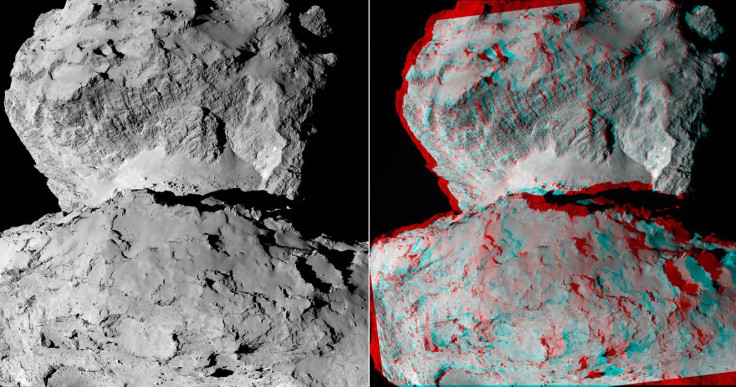Rosetta Captures 3D View Of Comet, Showing Incredible Surface Variations

The Rosetta spacecraft of the European Space Agency, or ESA, has recently captured two images of its target comet “67P/Churyumov-Gerasimenko,” which have been merged together to create a 3D image of the space projectile. According to astronomers, the new image of the comet shows the diversity of surface structures on the comet's nucleus.
In the 3D image, the comet’s head shows structures that resemble cliffs, while its neck displays scattered boulders on a comparatively smooth surface. The comet’s body, on the other hand, exhibits an uneven terrain with peaks and valleys having both smooth and rough topographic features. The Rosetta spacecraft, which arrived at the comet last week, snapped the pictures by using its OSIRIS narrow-angle camera on Aug. 7. While taking the pictures, the spacecraft was at a distance of 65 miles from the 2.5-mile-wide nucleus of the comet.
"Peer over cliffs and onto the boulder-strewn 'neck' region, marvel at the layers in the exposed cliff face, and ponder the formation of the numerous crater-like depressions in this amazing 3D view of comet 67P/C-G," ESA officials wrote in an image description.
Click here for a 3D version of the image.
The Rosetta spacecraft, which was launched in March 2004, was reactivated in January after 957 days in hibernation. The spacecraft, which is composed of an orbiter and lander, aims to study the comet in detail and prepare for landing a probe on its nucleus in November, while also tracking the changes the comet goes through as it sweeps past the sun, according to a NASA statement.
“The physical nature of the site is also an important factor: are there hazards such as large boulders or deep crevasses on the surface? Is the topography of the landing site suitable for the science experiments?” an ESA statement on the Rosetta mission said.
The observations by Rosetta are expected to help scientists learn more about the origin and evolution of the solar system, and better understand the role comets play in seeding Earth with water.
© Copyright IBTimes 2024. All rights reserved.





















